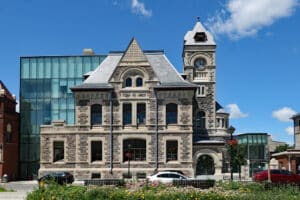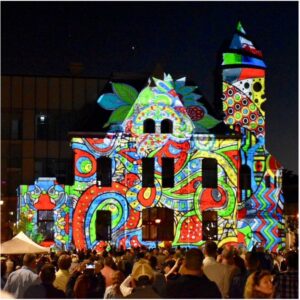Architectural Projection Mapping
- Paul Rennick
The Art and Science behind Projection Mapping is the act of taking a 2 or 3-dimensional visual image, and warping/twisting the image to present perfectly on an irregular shaped object. Gone are the days when projected images could only be presented onto flat, white surfaces. So what does this provide us with? Projection mapping allows us to take an inanimate object, with an irregular shape, and bring it to life with projected media, in an effort to tell a story or convey a message. A prime example would be with the City of Cambridge Ontario, Canada which projected their historic post office into the future throughout a digital transformation both internally and externally. The landmark building was in the midst of being repurposed from its original use-case into the city’s new “digital library” and what better way to commemorate the transition into the new era than bringing the exterior of the building to life.



In the modern era when a municipality’s assets can commonly live in the “cloud”, such as the case is for a digital library, it’s easy to lose sight of a physical structure’s significance and historical handiwork in shaping the community’s around it. Each of these structures can tell a story, and now through the advances of modern technology, a city’s vision, and a permanent fixture on the grounds within Cambridge, this building can continue to tell its 133-year long story, as well as many others for the foreseeable future.
When you see a well designed, and thoughtfully created projection mapping installation, be it permanent or temporary, its difficult not to stand in awe of how much a physical facility can come back to life. It’s seems so out of context, and vibrant that it’s captivating.
In its most simplest form it can seem that a projection mapping installment should be quite simple, and while it can seem that way there is a copious amount of planning, and a moderate amount of technological devices that go into getting an installment just right. Lastly if that planning and tech isn’t backed up by fantastic media content then its easy for the final product to come across as lack-lustre. Getting all the pieces to flow together is where the magic really takes place!
For organizations looking at the potential of creating an experience for their own patrons the process can seem quite daunting and the final price tag equally so. Pulling all of the previously mentioned pieces together takes a qualified firm, with the know-how, and resources to make the whole orchestra play together. To add to that, a projection mapping presentation is often proposed alongside another event already taking place. Seldom do projection mapping events take place unto themselves, and thus funds are often allocated to other facets of an event, and need to be shared across the board. Allocating the financial resources to accommodate a presentation such as this during another core event often creates the financial hurdle that most publicly funded events aren’t willing to, or able to jump. While the initial cost of a projection mapping event can seem high, you really need consider that cost as it pertains to the future of the community as-a-whole, rather than unto the event itself.
What do I mean by this? Well in the example of a community building being lit up, this becomes less of a one-time media presentation, and more of a public art installation. It’s been documented many times throughout history of the benefits of investing in public art-and-culture projects. When a community invests in art installations, it creates a “social rallying” where communities begin to celebrate what they have, and who they are as a community. The public begins to pride themselves on these spaces, and when this takes place then the benefits become cumulative. The “National League of Cities” (NLC), which represents municipalities across the United States published their annual “State of the Cities” report in which 9 out of the top 10 topics were directly influenced by Arts and Culture (Report found here).
A government organizations investment in arts and culture generates a pride of ownership for the communities within the residents who live there. It’s proven that this type of cultural mind-shift results in lower crime rates, increased infrastructure for lighting public spaces, bylaw enforcement towards residents negatively affecting other peoples quality of life in those neighbourhoods, and increased presence of law-enforcement all of which generates safer and more vibrant communities.
Safer, and more vibrant communities thrive.
People want to move their families to vibrant communities which generates more tax revenue. Business’s want to locate themselves in vibrant communities which generates more local employment. The benefit of public arts-and-culture investment starts to snowball into something greater than the sum of its parts. The benefits are cumulative and can be realized over a much larger amount of time as compared to a single event unto itself. Once an organization such as a municipality begins to think of an event in terms of what it contributes to the overall future vision of the community that they are attempting to create, as opposed to thinking about the event unto itself, then the cost-benefit ratio begins to blur and it becomes a far-more complex calculation with no definitive formula. Pushing that realization aside would be the equivalent of being a commuter, needing a car, and choosing against buying a car because of the initial financial outlay of $50,000. Keep in mind that the $50,000 investment isn’t a purchase made in isolation. That car will take you to, and from your place of employment which should in-theory pay you a much larger dividend in the long-run. Now add to that the idea that this place of employment offers a pension plan that will service you for decades longer than the car will last, and it becomes clear that you should start picking out hubcaps.
So good, we’re all in agreement that arts-and-culture is a worth-while investment (thanks for that). We still haven’t bridged the gap between arts-and-culture, and projection mapping specifically. Well let’s proceed down the proverbial rabbit hole a little further and continue building that bridge.
When someone mentions “The arts”, some folks can receive that term as something that they have trouble connecting to. The immediate thought process CAN be visions of standing in a gallery staring at painting of a red dot, trying to figure out what everyone else is apparently “seeing” and what the artist was “thinking”. To the average person they may not connect with this as being the type of “experience” that they would typically gravitate towards. Now you’ll notice the term I just used, “Experience”. Don’t get me wrong, I do believe that the average person could appreciate good art, but when you combine art + experience together you can start creating magical encounters that speak to art critics, and the general public alike.
The ”Center for Generational Kinetics” co-published a study where 74 percent of Americans now prioritize experiences over products or things (Study found here). “Baby Boomers (born 1946-64 are entering a stage where ‘less is more,’ while younger generations, particularly Millennials (defined as those born from 1977-95), are leading the charge in placing a newfound value on experiences, more than things,”.
When people are looking to reinvigorate their communities through arts and cultural festivals, and trying to make a bold statement about the community they live in, all while current generations are looking to be captivated by something that truly connects with them, it seems obvious to connect the dots. Short of combining Bungy-jumping and Pottery, I can’t think of a better combination. Trying to keep the clay on the wheel while plummeting towards certain death seems like a fruitless use of time and resources.
So now we’re convinced that art and experience should be married up and leave people with big feelings when they leave your event. Now how do we fund the experience?
Besides the separate topic of obtaining public grant money which we will address in another article, when contemplating funding that event lets keep in mind that captivating a stationary audience to provide them with an experience is every corporation’s dream! As an example studies specifically on marketing tactics to captivate Millennials have spoken to that many times over. Businessnewsdaily.com cites the top 10 sales and marketing tips for selling to Milllennials (article found here) and just the first 3 alone are as follows:
- Be authentic and genuine
- Build something bigger
- Remember that ownership isn’t everything
Municipalities should remember that the next time that they are attempting to work through budgetary constraints where projection mapping is a good fit. Offering a corporate sponsorship deal where a company can sponsor a singular experience within a larger event, where public digital art can be displayed, and then threading short, but interesting digital advertising pieces into the experience between show times, can be a stellar way to greatly offset event costs.
So the next time were looking at the costing of a projection mapping experience, lets look at the overall cost as it compares to the future benefit of the community, and leverage what we can to minimize the barriers to entry.
Some would conclude with something about how digital media experiences are the future staple of a great outdoor event, but I believe that the pioneering phase has already passed and the future is already here.
